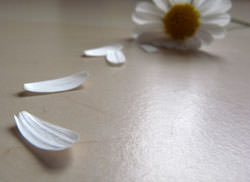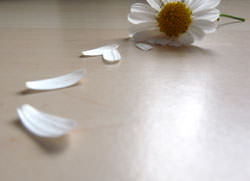Ricoh have finally decided to ditch the Caplio name tag and in my opinion it wasn’t too soon. Does this mean Ricoh have made any other changes that will have any adverse affects on the specification of the camera?
Ricoh GX200: Specification
- Resolution: 12.1Mp
- Sensor type: 1/1.7in primary-colour CCD
- Lens Focal length 24-72mm
- Metering: Multi (256 segments), Centre-weighted, Spot
- Aperture: f/2.5-f/4.4
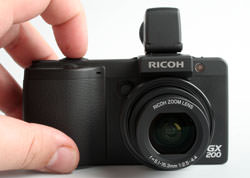
- Macro: Approx. 1cm
- Lens: 11 elements in 7 groups
- Zoom: 3x optical
- Sensitivity: ISO64-1600
- Monitor: 2.7in TFT LCD, approx. 460k dots
- Image size: [4:3]4000×3000, 3264×2448
- Recording format: RAW, JPEG
- Interface: USB2.0
- Battery: Li-Ion
- Dimensions: 111.6×58×25mm
- Weight: 208g
The GX200 at £400 offers a 12Mp CCD, 3x optical zoom and plenty of manual features for increasing your photographic quality including RAW recording and a new Smooth Imaging Engine III processor. Canon have the Powershot G9 at £100 less with the same resolution, larger 6x optical zoom and also has RAW recording with the new DIGIC III processor.
Alternatively, the Sigma DP-1 at £600 offers 14Mp on an APS-C sized sensor and dedicated TRUE sensor. It also has manual features, but lacks a zoom.
Ricoh GX200: Modes and features
As amused as I was to see the GX100 when it first came out the box, this time I was ready for seeing a camera that was, in essence, a bunch of squares stuck together. However the design of the predecessor must have struck a positive note with users as the GX200 is identical in appearance with the exception of a slightly larger screen on the back.
The layout has been modified slightly and the GX200 now sports a function button on the left navigation pad as well as the one on top of the camera.
The lens sticks out 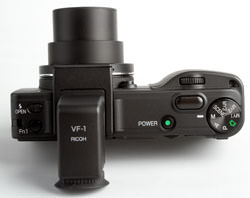 slightly at the front running level with the overhanging built-in flash but with the lens cap fitted, it pushes the front out by about 5mm. A small button just to the side of the lens is for removing the lens bezel allowing you to add lens attachments such as zoom or wide angle adapters.
slightly at the front running level with the overhanging built-in flash but with the lens cap fitted, it pushes the front out by about 5mm. A small button just to the side of the lens is for removing the lens bezel allowing you to add lens attachments such as zoom or wide angle adapters.
The top of the GX200 is exactly the same as the GX100 with a flash switch and the newly named fn1 button on the left shoulder while on the other side of the flash is a large expanse of space to hold a small power button, shutter release and mode dial. Sitting on the ledge of a small outcropping of the grip is a function dial for rotating through the menu options which are displayed on the screen.
Similarly to the top of the camera, the back has all the same buttons from the previous model. The VF/LCD button is for switching between the screen and the electronic viewfinder that comes supplied in certain kits. The viewfinder plugs into a port underneath the hotshoe which it sits on. A number of problems crop up with this 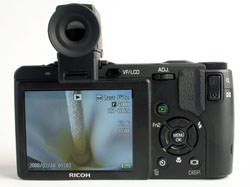 device: Firstly, the screen in the viewfinder isn’t very good and it’s simply easier to use the large screen on the rear of the camera. Secondly, while the viewfinder is being used, additional flash units can’t be fitted. Finally, despite being provided with a cover, the removable viewfinder could get knocked out of alignment if it gets in the way.
device: Firstly, the screen in the viewfinder isn’t very good and it’s simply easier to use the large screen on the rear of the camera. Secondly, while the viewfinder is being used, additional flash units can’t be fitted. Finally, despite being provided with a cover, the removable viewfinder could get knocked out of alignment if it gets in the way.
The viewfinder is the VF-1 model which the same that’s used on the GX100.
The Adjustment button has five dedications of which four can be changed if necessary. The AE/AF target shift can’t be changed but the exposure compensation, white balance, ISO and resolution can all be changed.
The function buttons can also be assigned different actions which is useful for a full day doing the same type of photography or if you have a particular function or style you like to stick to.
The buttons are set in the menu and can be assigned to features such as resolution, colour, focusing, white balance or ISO.
The mode option has been removed on the newer model and the up button on the navigation pad is now blank. It would have been nice to add a feature here such as a quick focus or metering button to leave the function buttons free for other features.
The zoom rocker is still too small in my opinion, but people with smaller hands shouldn’t find this a problem. The rest of the buttons are the regular ones you’d find on any compact such as playback, flash options, macro and self timer. The display button scrolls through the options of thirds grid, no information, information and histogram. The option to turn the screen off is added when the viewfinder is attached by pressing the VF/LCD button.
Ricoh GX200: Build and handling
Just like its predecessor, the GX200 is well made with a metal skeleton and a pleasant feeling plastic shell. The battery bay door is sturdy with little flex and I’m pleased to see a metal tripod bush. The same 24-72mm zoom lens has been used as on the earlier model and is still nice and smooth with small step increments. I stil maintain that they could have added a 4x optical zoom with no adverse problems.
Because of the materials used to build the camera, it’s slightly heavy for a compact in general but is lighter than similar ranged products such as the Sigma DP-1 and Canon Powershot G9.
Once you’ve mastered how to handle the function buttons and can work your way around the menu the rest simply falls into place.
Ricoh GX200: Performance
In the shutter lag test, the Ricoh GX200 fared a little slower than other compacts with a consistent result of 0.12sec which is about 0.04sec slower.
Once I’d finished using the shutter lag images, I wanted to do a selective erase so I didn’t remove the pictures I needed. Although this feature is available, it’s not overly forward at making itself known. When in playback, pressing the wide-angle button of the zoom rocker changes the images to thumbnails displaying around 20 shots at once. Then pressing the delete button over the shots you wish to remove will highlight them then pressing ok at the end will delete the selected images.
 The portrait shot. |
For the portrait test, I changed the camera to the portrait setting as well as taking a shot in aperture-priority and with a flash.
The portrait mode appears to boost the skin tones to give them a healthier glow as well as adding a little more dynamic range and giving smoother skin.
Aperture-priority gives a harsher result with a cooler tone that can be seen easily in the background wall.
The shot with the flash has filled in the shadows nicely, added some catchlights and balanced the whites out.
 The portrait in aperture priority mode. |
 The portrait with flash. |
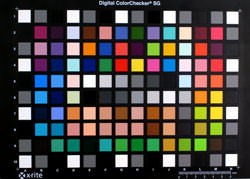 Most of the colours are pretty faithful but the blue has been oversaturated. |
The primary blue on the colour test chart is dark suggesting an over saturation from the processor. The other blues support this theory being quite rich as well.
The red and yellow colours are nicely balanced and I like the skin tone despite it being a bit too pink. The mono tones are good although I’d ask for the black to be a fraction more black than what it is.
The earthy tones are just that and the pastel colours in the surrounding tiles are acceptable.
The Ricoh GX200 has a close focusing of 1cm and in previous tests of other models with a similar capability, I think that the lens has a tendency to block out a lot of light. The shot of the flowers stamen is a little further away than the minimum distance but I wanted to see if the macro facility would automatically focus on the closest possible subject. This result shows that it doesn’t, so the AF adjustment will need to be employed or focusing in spot AF and reframing.
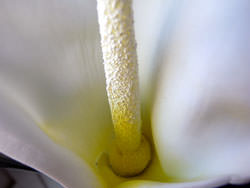 The macro image. |
The Ricoh GX200 has three continuous shooting modes and the standard setting managed 13 images in ten seconds while the S-Continuous (Stream) mode shot 16 images in two seconds but then stopped and took a further four seconds to download to the card. The images taken in this mode were all put onto one image which I fail to see the point of.
The other recording mode is called M-Continuous (memory-reversal) shooting and will record the previous two seconds of shooting while you hold down the shutter release. When the button is released, the camera transfers those two seconds to the card as one image.
These features were noted on the Ricoh R8 and while I mentioned that they could be useful I think it’ll take a lot of practice to get it right.
Ricoh GX200: Focusing and metering
Focusing speed of the GX200 is approximately just under two seconds which I think is quite slow. The reason being is that the camera will go through the entire focal plane trying to find a sharp subject before it settles. It does this by just tapping the shutter button which is nice if your finger slips, but otherwise time consuming.
The focus and metering are both adjustable on the GX200 and this feature is accessed by pressing the adjustment lever like a button. You can move through the tabs using the lever then use the navigation pad to choose the desired option. The AF and AE can’t be moved independently of one another in the AF/AE target lock.
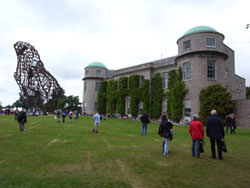 Metering from the grass using the AE target feature. The cloudy day reduced contrast. |
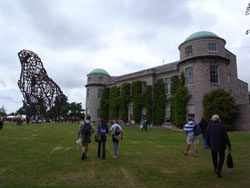 Metering from the sky brings more detail to the clouds just before the heavens opened. |
I metered for the sky in the shot of Goodwood house and because it was a cloudy day, it didn’t affect the overall exposure but brought out some detail in the clouds. Conveniently, the screen will darken and brighten as you move the AE target around so you can get an idea of what the exposure will look like.
Ricoh GX200: Noise test
It seems apt that after mentioning the Ricoh R8, we should come to the noise test. I was disappointed with the R8’s performance in the test and it’s unfortunate that the GX200 has the same problem. Looking at the GX100 review, the same noise result is there, but I’ve been more lenient so maybe I’m being too hard on Ricoh for this. However they have listed the GX range as professional on their site so you should expect professional results. The sensor is smaller than other cameras, which accounts for more noise, so maybe Ricoh need to rethink the sensor they use.
The image really starts to degrade from ISO400 onwards and at ISO800 coloured pixels start to creep in. The highest setting of ISO1600 has so much noise the image borders on hazy.
Ricoh GX200: Verdict I mentioned in the review of the GX100 and still maintain a year later that Ricoh aren’t taken as seriously as what they should be. Because they’ve been pretty quiet through the years, they’ve been overlooked by the regular consumers in favour of the bigger, more well known brands. What people fail to realise is that throughout this time, Ricoh have released some outstanding cameras.
I mentioned in the review of the GX100 and still maintain a year later that Ricoh aren’t taken as seriously as what they should be. Because they’ve been pretty quiet through the years, they’ve been overlooked by the regular consumers in favour of the bigger, more well known brands. What people fail to realise is that throughout this time, Ricoh have released some outstanding cameras.
You could do a lot worse than owning a camera like this and if you have £400 to spend on a well-built, high spec compact with manual features then this is the camera for you.
Ricoh GX200: Plus points![]() Excellent build
Excellent build![]() Good macro
Good macro![]() AF/AE adjustment
AF/AE adjustment![]() Good portrait mode
Good portrait mode
Ricoh GX200: Minus points![]() Bad noise
Bad noise![]() Separate viewfinder
Separate viewfinder![]() Still no shutter priority
Still no shutter priority
 FEATURES
FEATURES![]()
HANDLING![]()
PERFORMANCE![]()
OVERALL![]()
Despite the GX200 having issues with noise, the camera’s performance and features outweigh the negative points. Because of that I’ve given the camera a highly recommended award.
The Ricoh GX200 costs around £400 with the viewfinder and £350 without.
It’s available from the ePHOTOzine shop here.
